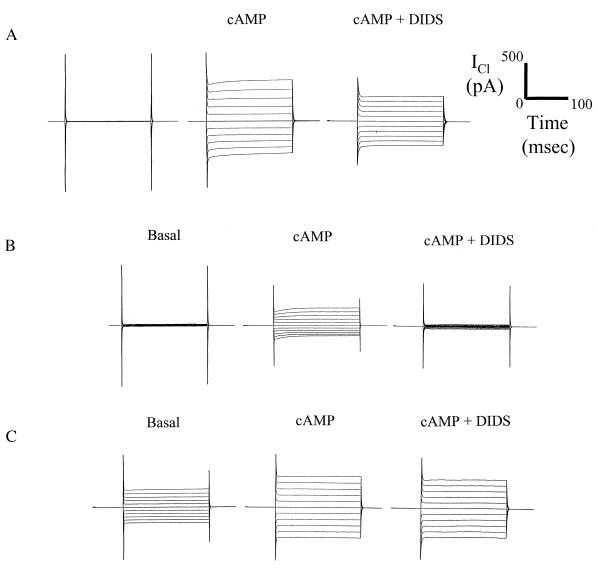Figure 2.
Recordings of whole cell currents of wild-type and various mutant CFTRs expressed in cultured bronchial CF epithelial cells (IB3–1). (A) Wild-type CFTR: representative whole cell patch-clamp recordings of basal, cAMP-stimulated, and DIDS-inhibited cAMP-stimulated Cl− currents in wild-type CFTR-transfected IB3–1 cells. cDNA constructs were transfected transiently into IB3–1 CF cells and studied in physiological assays 72 hr after transfection in comparison to wild-type CFTR, mock-transfected cells, and parental IB3–1 cells. DIDS (500 μM) inhibited the outwardly rectifying current, whereas the remaining, underlying linear current (CFTR current) was unaffected (−100 mV to +100 mV in 20-mV increments from holding voltage of 0 mV). (B) Δ259-M265V CFTR: Typical whole cell patch-clamp recordings of basal, cAMP-stimulated, and DIDS-inhibited cAMP-stimulated Cl− currents from a Δ259-M265V-transfected cell. DIDS (500 μM) inhibited all of the current that was significantly outward rectified; no underlying linear current (CFTR current) was observed. (C) TMD-1 CFTR: Representative whole cell patch-clamp recordings of basal, cAMP-stimulated, and DIDS-uninhibited cAMP-stimulated Cl− currents from a TMD-1-transfected cell. DIDS (500 μM) failed to inhibit the current observed, indicating that the linear current was due to CFTR channel activity exclusively (see Fig. 3 for summarized data for all mutants).

